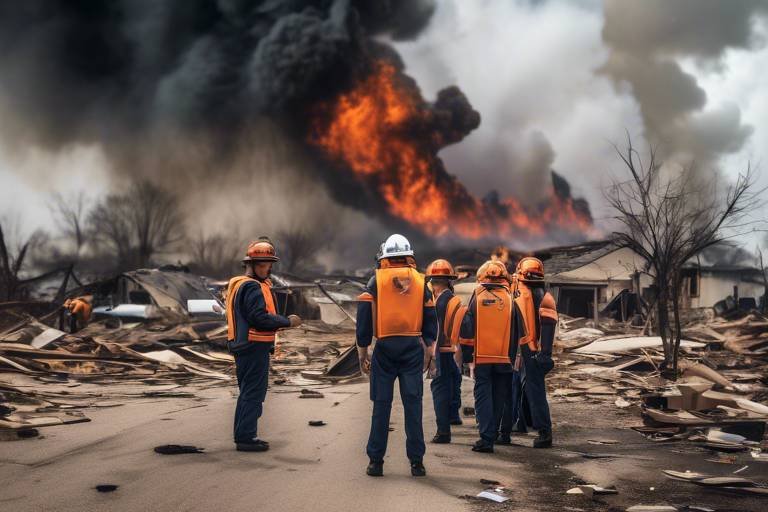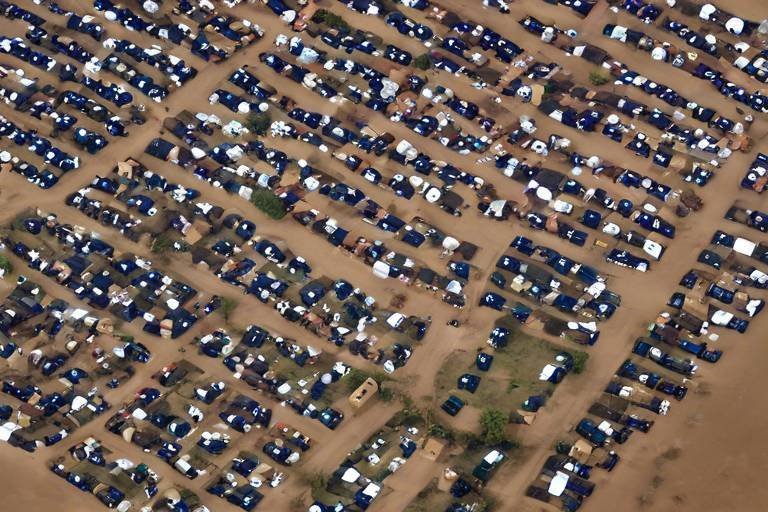How Technology is Influencing Disaster Response Training
In today’s fast-paced world, technology is reshaping every aspect of our lives, and disaster response training is no exception. Imagine a scenario where emergency responders can practice their skills in a virtual environment, simulating real-life disasters without any risk. This is not just a dream; it’s a reality thanks to the advent of advanced technologies. As we delve deeper into the transformative role of technology in disaster response training, we uncover innovative tools and methods that significantly enhance preparedness and effectiveness during emergencies. From immersive virtual reality simulations to mobile applications that provide on-the-go training, technology is paving the way for a new era in emergency management.
One of the most exciting developments is the use of virtual reality (VR). This technology immerses trainees in realistic scenarios, allowing them to practice their responses without the consequences of a real disaster. Think of it as a flight simulator for emergency responders. By replicating high-pressure situations, VR not only enhances skills retention but also hones decision-making abilities when it matters most. Imagine being able to navigate through a simulated earthquake or a flood, making critical decisions in real-time, all from the safety of a training facility.
Moreover, the rise of mobile applications has revolutionized how responders access training resources. Picture this: you’re on the go, but you need to brush up on your first aid skills or review emergency protocols. With just a few taps on your smartphone, you can access interactive content, videos, and real-time updates on best practices. This flexibility allows responders to learn and practice skills anytime, anywhere, ensuring they are always prepared for the unexpected.
But it doesn’t stop there! One of the most engaging aspects of modern training is the incorporation of gamification. By adding game elements to disaster response training, organizations can significantly increase engagement and motivation among participants. Imagine competing with your colleagues to solve a simulated disaster scenario, working together as a team while also having fun. Gamification fosters a spirit of collaboration and problem-solving, making the learning experience both competitive and educational.
- What is virtual reality training? Virtual reality training involves using VR technology to simulate realistic emergency scenarios, allowing responders to practice their skills in a safe environment.
- How do mobile applications enhance disaster response training? Mobile apps provide on-the-go access to training resources, enabling responders to learn and practice skills anytime, anywhere, often with interactive content.
- What is gamification in training? Gamification incorporates game-like elements into training programs to increase engagement and motivation, encouraging teamwork and problem-solving.
- How can data analytics improve training programs? Data analytics offers insights into training effectiveness, helping organizations identify strengths and weaknesses, guiding improvements in training methods.
- What role do drones play in disaster response training? Drones provide hands-on experience with aerial surveillance, enhancing situational awareness and operational efficiency during emergency scenarios.

Virtual Reality Simulations
Virtual reality (VR) is revolutionizing disaster response training by providing an immersive experience that traditional methods simply cannot match. Imagine being able to step into a simulated earthquake zone or a flood-affected area without ever leaving your training facility. This technology allows responders to practice their skills in a realistic environment, where they can make mistakes and learn from them without the dire consequences that would occur in a real disaster. By engaging in these simulations, trainees can enhance their skills retention, which is crucial when every second counts during an actual emergency.
One of the most significant advantages of VR simulations is the ability to replicate high-stress situations that responders might face in the field. For instance, a firefighter can practice navigating through a smoke-filled building, while a paramedic can learn to assess patients in chaotic scenarios. This hands-on experience in a controlled setting helps build confidence and improves decision-making under pressure. As trainees encounter various challenges, they develop critical thinking and adaptability—skills that are essential during real-life disasters.
Moreover, VR simulations can be tailored to fit specific scenarios that responders are likely to encounter in their regions. This customization ensures that the training is relevant and applicable, which significantly enhances the overall learning experience. For example, a team in a coastal area might train for hurricane response, while those in urban settings could focus on mass casualty incidents. The ability to simulate these diverse situations is a game-changer in disaster preparedness.
In addition to practical skills, VR training can also foster teamwork and communication among responders. Many simulations are designed for groups, requiring participants to collaborate effectively to solve problems and manage crises. This aspect of training not only builds camaraderie but also teaches the importance of clear communication during emergencies, where miscommunication can lead to tragic outcomes.
To illustrate the impact of VR on disaster response training, consider the following table that highlights key benefits:
| Benefits of VR Simulations | Description |
|---|---|
| Immersive Learning | Engages trainees in realistic scenarios for better skill retention. |
| Safe Environment | Allows for mistakes without real-world consequences. |
| Customization | Training can be tailored to specific regional scenarios. |
| Team Building | Encourages collaboration and communication among responders. |
In conclusion, virtual reality simulations are not just a trend; they are a transformative tool in disaster response training. By providing a safe, engaging, and realistic environment for learning, VR is helping to create more prepared and effective responders. As technology continues to evolve, we can expect even more innovative applications of VR in enhancing disaster preparedness and response capabilities.

Mobile Applications for Training
In today's fast-paced world, the need for effective disaster response training has never been more critical. Enter mobile applications, the unsung heroes of the training landscape! These nifty tools are revolutionizing how responders prepare for emergencies, offering a level of flexibility and accessibility that traditional training methods simply can't match. Imagine being able to access vital training resources right from your pocket, whether you're at home, on a bus, or even in the field. That's the magic of mobile apps!
Mobile applications are designed to provide on-the-go access to a wealth of training materials. They often include interactive content, such as videos, quizzes, and real-life case studies, which engage users and enhance their learning experience. This interactivity is crucial; after all, how often do we remember something we've merely read versus something we've actively engaged with? Moreover, these apps are frequently updated with the latest best practices and guidelines, ensuring that responders are always in the loop. It's like having a personal trainer for disaster response right in your pocket!
But that's not all—many of these applications also feature social components that foster collaboration among responders. For instance, users can share their progress, exchange tips, and even participate in discussion forums. This sense of community is invaluable, especially in a field where teamwork is essential. Imagine a firefighter in one city sharing insights with a paramedic in another, all thanks to a mobile app! It breaks down geographical barriers and creates a network of knowledge that enhances overall preparedness.
One of the standout features of these mobile applications is their ability to offer real-time updates. In the ever-changing landscape of disaster response, being informed about the latest protocols or techniques can mean the difference between life and death. With a mobile app, responders can receive instant notifications about new training modules, emergency alerts, or even changes in local disaster response strategies. This immediacy helps to cultivate an environment where learning is continuous and responsive to the current needs of the community.
Furthermore, the gamification of training within these apps adds an exciting layer to the learning process. Users can earn badges or points for completing modules, participating in quizzes, or sharing knowledge. This not only makes learning fun but also motivates users to engage more deeply with the material. It's like turning training into a game, where the stakes are high, and the rewards are not just points, but the skills needed to save lives!
To wrap it all up, mobile applications are transforming disaster response training into a dynamic, engaging, and accessible experience. They empower responders to learn at their own pace, collaborate with peers, and stay updated with the latest practices. As technology continues to evolve, the potential for mobile applications in this field is limitless. So, if you're a responder looking to up your game, don’t overlook the power of mobile training apps—they might just be your new best friend!
- What types of training can mobile applications provide?
Mobile applications can offer a variety of training resources, including interactive modules, videos, quizzes, and real-time updates on best practices in disaster response. - Are these applications suitable for all levels of responders?
Yes, mobile applications are designed to cater to responders of all levels, from beginners to seasoned professionals, ensuring that everyone can benefit from the training provided. - Can I access these apps offline?
Many mobile applications allow users to download content for offline access, ensuring that responders can continue their training even without an internet connection.

Gamification in Training
Gamification in disaster response training is like adding a sprinkle of magic to a serious subject. Imagine turning a mundane training session into an engaging adventure where participants are not just passive learners but active players in a game. By incorporating game elements such as points, badges, and challenges, trainers can significantly boost motivation and engagement levels among responders. It’s akin to transforming a traditional classroom into an exhilarating battlefield where every decision counts and teamwork is crucial.
The beauty of gamification lies in its ability to create a competitive yet collaborative environment. Responders are encouraged to work together to solve problems, strategize, and navigate through realistic disaster scenarios. Picture a team of trainees racing against the clock to save virtual victims while managing limited resources. This not only enhances their critical thinking skills but also fosters a sense of camaraderie that is essential during real-life emergencies.
Moreover, gamification allows for scenario-based learning, where trainees can encounter various challenges that mimic real-world disasters. For instance, they might face a simulated earthquake scenario where they must prioritize rescue operations, allocate resources, and communicate effectively under pressure. This immersive experience sharpens their decision-making skills and prepares them for the unpredictability of actual disaster situations.
To make the training even more exciting, many programs integrate leaderboards and reward systems. These features add a layer of excitement, as participants can see their progress in real-time and strive to climb to the top of the leaderboard. Rewards can range from simple recognition to tangible prizes, creating a culture of continuous improvement and encouraging responders to hone their skills consistently.
In summary, gamification in disaster response training is not just a trend; it’s a revolutionary approach that transforms how responders learn and prepare for emergencies. By engaging them in a fun and interactive way, we not only enhance their skills but also build stronger, more cohesive teams ready to tackle real-world challenges head-on.
- What is gamification in training?
Gamification in training involves integrating game-like elements into educational programs to enhance engagement, motivation, and learning outcomes. - How does gamification improve disaster response training?
It creates a competitive environment that encourages teamwork and problem-solving, allowing participants to practice critical skills in realistic scenarios. - Can gamification be applied to other training areas?
Yes, gamification can be applied to various fields, including corporate training, healthcare, and education, to enhance learning experiences. - What are some examples of gamification in disaster response?
Examples include scenario-based challenges, leaderboards, and reward systems that incentivize participation and skill development.

Leaderboards and Rewards
In the realm of disaster response training, serve as powerful tools to boost engagement and foster a sense of community among participants. Imagine a bustling training environment where each responder is not just a passive learner, but an active competitor striving to outdo their peers. This competitive spirit can significantly enhance the learning experience, making it both enjoyable and effective. By incorporating leaderboards, organizations can visually display the progress of trainees, showcasing their achievements and encouraging a friendly rivalry that motivates everyone to improve.
But why stop at just leaderboards? Adding a rewards system can elevate this experience even further. Rewards can range from simple recognitions, like certificates or badges, to tangible prizes such as gift cards or exclusive training opportunities. These incentives not only recognize individual accomplishments but also promote team cohesion as members rally together to achieve common goals. When responders know that their efforts will be acknowledged, they are more likely to engage fully in the training process, pushing themselves to master new skills and techniques.
Moreover, the combination of leaderboards and rewards creates a feedback loop that reinforces positive behavior. For instance, if a trainee excels in a particular area, they might receive points on the leaderboard, which in turn earns them a reward. This system encourages participants to continuously strive for excellence, knowing that their hard work will not go unnoticed. It’s like turning the training room into a game where everyone is a player, and every effort counts. As a result, the overall effectiveness of the training program improves, leading to better-prepared responders ready to tackle real-world challenges.
Ultimately, the integration of leaderboards and rewards in disaster response training not only enhances motivation but also cultivates a culture of continuous improvement. By celebrating successes and encouraging healthy competition, organizations can build a more skilled and confident team. This approach transforms training from a mundane task into an exciting journey of growth and development, ensuring that when disaster strikes, responders are not just ready—they're eager to make a difference.
- What are leaderboards in disaster response training?
Leaderboards are visual displays that track and showcase the progress and achievements of participants in training programs, fostering competition and motivation. - How do rewards enhance training?
Rewards recognize individual and team accomplishments, promoting engagement and encouraging participants to strive for excellence in their training. - Can leaderboards be used for team training?
Absolutely! Leaderboards can track team performance, encouraging collaboration and teamwork while still maintaining a competitive edge. - What types of rewards are effective in training?
Effective rewards can include certificates, badges, gift cards, or exclusive opportunities for advanced training, tailored to what motivates your team.

Scenario-Based Learning
Scenario-based learning is a revolutionary approach in disaster response training that immerses trainees in realistic, high-pressure situations. Imagine being in the middle of a chaotic earthquake aftermath, where every second counts, and the decisions you make could save lives. This method not only enhances critical thinking but also cultivates adaptability, which is crucial in real disaster scenarios. Rather than simply memorizing procedures, responders engage in simulated environments that challenge their problem-solving skills and teamwork.
One of the key benefits of scenario-based learning is its ability to mimic the unpredictability of actual disasters. Trainees are placed in various scenarios, such as natural disasters, terrorist attacks, or public health emergencies, where they must assess the situation and respond accordingly. This hands-on experience fosters a deeper understanding of the complexities involved in disaster response. For example, a scenario might involve a multi-vehicle accident on a busy highway, requiring responders to prioritize victims based on the severity of their injuries while coordinating with multiple agencies.
Additionally, scenario-based learning often incorporates elements of gamification. This means that trainees can compete against each other or work in teams to solve problems, making the learning process more engaging and enjoyable. The competitive aspect encourages participants to think creatively and develop innovative solutions to challenges they may face in real-life situations. By integrating gamification, training becomes not just a chore but an exciting challenge that participants look forward to.
Moreover, this type of learning can be tailored to meet the specific needs of different teams or organizations. For instance, a fire department may focus on fire rescue scenarios, while a medical team might practice triage in a mass casualty incident. This customization ensures that each trainee receives relevant experience that directly correlates with their roles in disaster response. The flexibility of scenario-based learning allows for a wide range of situations to be addressed, ensuring comprehensive preparedness.
To illustrate the effectiveness of scenario-based learning, consider the following table that outlines the key components and benefits:
| Component | Benefit |
|---|---|
| Realistic Simulations | Enhances decision-making skills under pressure |
| Team Collaboration | Fosters communication and teamwork |
| Customizable Scenarios | Aligns training with specific organizational needs |
| Gamified Elements | Increases engagement and motivation |
| Critical Thinking Challenges | Improves adaptability in unexpected situations |
In conclusion, scenario-based learning is an invaluable tool in disaster response training. It not only prepares responders for the realities of their roles but also equips them with the skills necessary to handle the unpredictable nature of emergencies. By immersing trainees in realistic scenarios, we can ensure they are not just trained but truly prepared for whatever challenges may come their way.
Q: What is scenario-based learning?
A: Scenario-based learning is a training method that immerses participants in realistic, high-pressure situations to enhance their critical thinking, decision-making, and adaptability during emergencies.
Q: How does gamification enhance scenario-based learning?
A: Gamification introduces competitive elements and teamwork into training, making it more engaging and motivating for participants. It encourages creative problem-solving while fostering collaboration.
Q: Can scenario-based learning be customized for different organizations?
A: Yes, scenario-based learning can be tailored to meet the specific needs and challenges faced by different teams or organizations, ensuring relevant training experiences.
Q: What are the benefits of using realistic simulations in training?
A: Realistic simulations enhance decision-making skills, improve teamwork, and prepare responders for the unpredictable nature of real-life disasters.

Remote Learning Platforms
In today's fast-paced world, the need for effective disaster response training has never been more critical. Remote learning platforms have emerged as a game-changer in this arena, providing unprecedented access to training resources and expert-led sessions. Imagine being able to connect with specialists from around the globe, all from the comfort of your own home or training facility. This flexibility not only enhances learning opportunities but also fosters collaboration among diverse teams, breaking down geographical barriers that once hindered effective training.
These platforms offer a variety of formats for learning, including live webinars, recorded sessions, and interactive modules. This variety caters to different learning styles and schedules, making it easier for responders to engage with the material. For instance, a firefighter in a rural area can participate in a live training session with a renowned disaster management expert based in a major city, gaining insights that would have been impossible to access otherwise. This democratization of knowledge is essential for building a more prepared workforce.
Moreover, remote learning platforms often incorporate advanced features such as chat rooms and discussion forums, where trainees can ask questions and share experiences in real time. This interactive element not only enhances understanding but also builds a sense of community among responders. As they navigate through complex scenarios and share best practices, they develop a network of support that can be invaluable during actual emergencies. It's like having a virtual safety net, ensuring that no one feels isolated in their training journey.
To illustrate the effectiveness of these platforms, consider the following table that highlights key features and benefits:
| Feature | Benefit |
|---|---|
| Live Webinars | Real-time interaction with experts |
| Recorded Sessions | Flexibility to learn at your own pace |
| Interactive Modules | Engaging and hands-on learning experience |
| Discussion Forums | Building a community and sharing knowledge |
As we move further into an era defined by technological advancements, the integration of remote learning platforms into disaster response training is not just a trend; it's a necessity. These platforms empower responders to be better prepared, more knowledgeable, and ultimately more effective in the face of disasters. They serve as a bridge, connecting individuals and teams with the resources they need to thrive. So, whether you're a seasoned professional or a newcomer to the field, embracing these platforms can significantly enhance your training experience and readiness for real-world challenges.
- What are remote learning platforms? Remote learning platforms are online systems that facilitate training and educational sessions, allowing participants to learn from anywhere in the world.
- How do remote learning platforms enhance disaster response training? They provide access to expert-led sessions, interactive content, and community support, making training more accessible and effective.
- Can I interact with instructors during remote training? Yes! Many remote learning platforms offer live webinars and discussion forums for real-time interaction.
- Are there any costs associated with using these platforms? Some platforms may charge fees for certain courses, while others may offer free resources. It's best to check the specific platform for details.

Data Analytics for Training Improvement
In the dynamic world of disaster response, the ability to adapt and improve training programs is crucial. This is where data analytics steps in as a game-changer. By harnessing the power of data, organizations can gain valuable insights into the effectiveness of their training initiatives. Imagine being able to pinpoint exactly what works and what doesn’t, all thanks to the meticulous collection and analysis of training data. This not only enhances the quality of training but also ensures that responders are well-prepared for real-world scenarios.
Data analytics allows organizations to track various metrics that can illuminate the strengths and weaknesses of their training programs. For instance, by analyzing participant performance, engagement levels, and feedback, trainers can identify patterns that reveal areas needing improvement. This process is akin to a coach reviewing game footage to strategize for the next match. The goal is to evolve continuously, ensuring that every training session is more effective than the last.
One key aspect of utilizing data analytics is the implementation of feedback mechanisms. By encouraging trainees to share their experiences and thoughts on the training they receive, organizations can create a two-way street of information flow. This feedback can be quantified and analyzed to determine common themes or issues that need addressing. For example, if multiple participants express difficulty in a specific area, trainers can focus on enhancing that part of the curriculum.
Moreover, tracking performance metrics is essential in assessing the impact of training on disaster response capabilities. Metrics such as response times, accuracy in simulations, and teamwork efficiency can provide a comprehensive picture of how well responders are equipped to handle emergencies. By regularly reviewing these metrics, organizations can make data-driven decisions that lead to more effective training designs. This could involve adjusting the difficulty level of scenarios or incorporating new technologies that better reflect current challenges in disaster response.
To illustrate the importance of data analytics in training improvement, consider the following table showcasing common performance metrics and their significance:
| Performance Metric | Significance |
|---|---|
| Response Time | Measures how quickly responders can act in simulated scenarios, indicating readiness. |
| Accuracy in Simulations | Assesses the precision of actions taken during training, reflecting knowledge and skills. |
| Teamwork Efficiency | Evaluates how well participants collaborate, crucial for real-world disaster response. |
| Participant Engagement | Tracks how actively trainees participate, which can correlate with retention and performance. |
In conclusion, the integration of data analytics into disaster response training not only enhances the effectiveness of the programs but also fosters a culture of continuous improvement. By leveraging data, organizations can create tailored training experiences that evolve with emerging challenges, ensuring that responders are always at the top of their game. After all, in the world of disaster response, being prepared can make all the difference.
- What is the role of data analytics in disaster response training?
Data analytics helps organizations assess the effectiveness of their training programs by tracking performance metrics, gathering feedback, and identifying areas for improvement. - How can feedback mechanisms enhance training?
Feedback mechanisms allow trainees to share their experiences, enabling trainers to refine the curriculum based on real participant insights. - Why are performance metrics important?
Performance metrics provide measurable data that can indicate the readiness and effectiveness of responders, guiding future training adjustments. - Can data analytics predict training outcomes?
While not definitive, data analytics can help identify trends that may suggest how well trainees will perform in real-world situations based on their training data.

Feedback Mechanisms
In the realm of disaster response training, play a pivotal role in shaping the effectiveness of programs. Imagine a world where responders can voice their experiences, share insights, and suggest improvements after each training session. This is not just a dream; it’s a reality that organizations are increasingly embracing to foster a culture of continuous improvement.
Feedback mechanisms can take various forms, from simple surveys to interactive forums where trainees can discuss their experiences. By implementing these tools, organizations can gain invaluable insights into what works and what doesn’t, allowing them to tailor training programs to meet the needs of all participants. For instance, after a training session, responders could fill out a survey that asks questions like:
- What aspects of the training did you find most useful?
- Were there any areas that you felt needed improvement?
- How confident do you feel in applying what you learned?
These questions not only help in assessing the immediate impact of the training but also serve as a foundation for future sessions. By analyzing the data collected, organizations can identify common trends and areas for enhancement. This iterative process ensures that training remains relevant and effective, adapting to the ever-evolving landscape of disaster response.
Moreover, the importance of feedback extends beyond mere assessment; it fosters a sense of community among responders. When trainees see that their voices are heard and their suggestions are implemented, it cultivates a deeper commitment to the training process. This engagement can lead to increased motivation, as responders feel they are part of a team that values their input and strives for excellence.
Incorporating technology into feedback mechanisms can further enhance their effectiveness. For example, using online platforms allows for real-time feedback collection and analysis. Responders can provide their thoughts immediately after training, while organizations can quickly adapt their programs based on this input. This agility is crucial in disaster response training, where the stakes are high, and preparedness is essential.
In conclusion, establishing robust feedback mechanisms within disaster response training is not just a best practice; it’s a necessity. By listening to trainees, organizations can create more effective programs that not only prepare responders for real-world challenges but also foster a culture of collaboration and continuous improvement.
- What are feedback mechanisms? Feedback mechanisms are tools and processes that allow participants to provide input on their training experiences, helping organizations improve their programs.
- Why are feedback mechanisms important in disaster response training? They are crucial for assessing training effectiveness, identifying areas for improvement, and fostering a sense of community among responders.
- How can technology enhance feedback collection? Technology can facilitate real-time feedback through online platforms, allowing for quicker analysis and adaptation of training programs.
- What types of feedback can be collected? Feedback can range from quantitative data, such as survey scores, to qualitative insights, like personal experiences and suggestions for improvement.

Performance Metrics
When it comes to disaster response training, are the backbone that supports continuous improvement and effectiveness. Measuring how well training programs prepare responders is essential for ensuring they can handle real-life emergencies with confidence. Think of performance metrics as a compass that guides organizations toward better training outcomes. By analyzing various metrics, organizations can identify areas for enhancement and make data-driven decisions that ultimately lead to more effective disaster response teams.
One of the key aspects of performance metrics is the ability to track specific indicators that reflect the trainees' skills and readiness. These indicators can include:
- Response Time: How quickly trainees can mobilize and respond to simulated emergencies.
- Decision-Making Skills: Evaluating how well trainees make critical decisions under pressure.
- Team Coordination: Assessing how effectively teams work together during exercises.
- Knowledge Retention: Measuring how much information trainees can recall after the training sessions.
By gathering data on these performance metrics, organizations can create a comprehensive overview of their training's effectiveness. For instance, if a particular group consistently shows slower response times, it may indicate a need for more focused training in that area. On the other hand, if decision-making skills are high, it can be a sign that the current training methods are working well.
Moreover, performance metrics can be visualized through
| Training Cohort | Average Response Time (minutes) | Decision-Making Score (out of 10) |
|---|---|---|
| Group A | 5.2 | 8.5 |
| Group B | 7.8 | 7.0 |
| Group C | 4.6 | 9.0 |
This table helps trainers visualize performance, making it easier to identify which cohorts are excelling and which may need additional resources or changes in training strategy. In essence, performance metrics not only highlight the strengths and weaknesses of training programs but also foster a culture of accountability and improvement among responders.
In conclusion, integrating performance metrics into disaster response training creates a robust framework for evaluating and enhancing the preparedness of teams. By leveraging data, organizations can ensure that their responders are not just trained but are truly ready to face the challenges of real-world emergencies. After all, in the world of disaster response, every second counts, and having a well-prepared team can make all the difference.
Q1: What are performance metrics in disaster response training?
A1: Performance metrics are specific indicators used to measure the effectiveness of training programs, including response times, decision-making skills, and team coordination.
Q2: How can performance metrics improve training outcomes?
A2: By analyzing performance metrics, organizations can identify strengths and weaknesses in their training programs, allowing for data-driven improvements that enhance preparedness.
Q3: Why is tracking response time important?
A3: Response time is crucial because it reflects how quickly trainees can mobilize in emergencies, which can significantly impact the outcome during real disasters.
Q4: Can performance metrics help in team coordination?
A4: Yes, performance metrics can assess how well teams work together, providing insights that can lead to improved collaboration and effectiveness in disaster response scenarios.

Integration of Drones and Robotics
This article explores the transformative role of technology in disaster response training, highlighting innovative tools, methods, and strategies that enhance preparedness and effectiveness in emergency situations.
Virtual reality (VR) offers immersive training experiences, allowing responders to practice in realistic scenarios without real-world consequences. This technology enhances skills retention and decision-making under pressure.
Mobile applications provide on-the-go access to training resources, enabling responders to learn and practice skills anytime, anywhere. These apps often include interactive content and real-time updates on best practices.
Incorporating game elements into disaster response training increases engagement and motivation among participants. Gamification encourages teamwork and problem-solving in a competitive yet educational environment.
Using leaderboards and rewards systems can further incentivize participation in training programs, fostering a culture of continuous improvement and skill enhancement among responders.
Scenario-based learning through gamification allows trainees to face realistic challenges, enhancing their critical thinking and adaptability in actual disaster situations.
Remote learning platforms facilitate access to expert-led training sessions and resources, breaking geographical barriers and allowing diverse teams to collaborate and learn together effectively.
Data analytics provides insights into training effectiveness, helping organizations identify strengths and weaknesses in their programs. This information guides improvements and ensures that training evolves with emerging challenges.
Implementing feedback mechanisms allows trainees to share their experiences, fostering a culture of continuous improvement and ensuring that training meets the needs of all participants.
Tracking performance metrics enables organizations to assess the impact of training on disaster response capabilities, ultimately leading to more effective and prepared teams in real-world situations.
The integration of drones and robotics into disaster response training is revolutionizing how responders prepare for emergencies. With the ability to simulate real-life scenarios, these technologies provide hands-on experience that is invaluable. Imagine a scenario where a natural disaster has struck, and traditional methods of assessment and response are insufficient. This is where drones come into play, offering aerial views that can pinpoint areas most in need of assistance.
During training, responders can utilize drones to conduct search and rescue operations. By deploying drones equipped with high-resolution cameras, trainees learn to assess disaster zones from above, identifying victims and obstacles that may not be visible from the ground. This technology not only enhances situational awareness but also significantly improves the speed and efficiency of rescue operations. For instance, a drone can cover vast areas in a fraction of the time it would take a team on foot, allowing for a quicker response to those in distress.
Furthermore, robotics play a critical role in logistics and supply chain management during disasters. Trainees can engage with robotic systems that are designed to transport supplies, navigate through debris, and even assist in setting up temporary shelters. This hands-on experience is crucial, as it equips responders with the knowledge of how to effectively use these technologies in chaotic environments. The table below illustrates the key benefits of using drones and robotics in disaster response training:
| Technology | Benefits |
|---|---|
| Drones |
|
| Robotics |
|
As we continue to embrace these technologies, the future of disaster response training looks promising. The combination of drones and robotics not only prepares responders for the challenges they will face but also instills confidence in their abilities to manage complex situations. With each training session, teams become more adept at leveraging these tools, ensuring they are ready for whatever disaster may come their way.
- How do drones improve disaster response training?
Drones provide aerial views that help responders assess situations quickly and accurately, significantly improving decision-making during emergencies. - What role do robotics play in disaster scenarios?
Robotics assist in logistics and supply chain management, allowing for efficient resource distribution and support in hazardous environments. - Can virtual reality be used alongside drones in training?
Absolutely! Virtual reality can simulate drone operations, giving trainees a comprehensive understanding of both technologies in a controlled environment.

Search and Rescue Operations
In the realm of disaster response, stand out as one of the most critical components. The ability to locate and assist individuals trapped or affected by disasters can mean the difference between life and death. With the advent of technology, particularly drones, the landscape of these operations has transformed dramatically. Imagine being able to survey vast areas in a matter of minutes, pinpointing those in need of help with precision that was once unimaginable.
Drones equipped with high-resolution cameras and thermal imaging capabilities have revolutionized how responders approach search and rescue missions. These flying machines can cover extensive areas quickly, providing real-time data and visuals that ground teams might miss. For instance, during a natural disaster like an earthquake or flood, responders can deploy drones to assess damage, locate survivors, and even deliver supplies to hard-to-reach places.
Moreover, training with drones is not just about flying them; it's about understanding their operational intricacies and how they can be integrated into a broader response strategy. Responders learn to interpret the data collected by drones, making quick decisions based on aerial footage. This hands-on experience is invaluable, as it prepares them for real-life scenarios where every second counts.
To illustrate the impact of drone technology in search and rescue operations, here’s a quick comparison of traditional methods versus drone-assisted methods:
| Aspect | Traditional Methods | Drone-Assisted Methods |
|---|---|---|
| Time to Locate | Hours to days | Minutes to hours |
| Area Coverage | Limited, often on foot | Extensive, aerial view |
| Data Collection | Manual, prone to errors | Automated, real-time analytics |
| Risk to Personnel | High, especially in dangerous zones | Low, drones can access hazardous areas |
This table highlights the stark differences in effectiveness and safety that drones bring to search and rescue operations. As we move forward, the challenge lies in ensuring that all responders are adequately trained to utilize these technologies. The integration of drones into training programs is essential, as it equips responders with the necessary skills to leverage this technology effectively in the field.
In conclusion, the future of search and rescue operations is bright, thanks to technological advancements. Drones not only enhance operational efficiency but also provide a new layer of safety for responders. As we continue to innovate and adapt, the goal remains the same: to save lives and provide assistance in the most effective manner possible.
- What types of drones are used in search and rescue operations? Drones equipped with thermal imaging, high-resolution cameras, and GPS capabilities are commonly used.
- How does drone training differ from traditional search and rescue training? Drone training focuses on aerial surveying, data interpretation, and technology integration, while traditional training emphasizes ground-based search techniques.
- Are drones effective in all types of disasters? While drones are highly effective in many scenarios, their utility can vary based on environmental conditions such as heavy rain or strong winds.
- What are the legal considerations for using drones in disaster response? Operators must comply with local regulations regarding airspace and privacy, and training programs often include guidance on these legal aspects.

Logistics and Supply Chain Management
In the chaotic aftermath of a disaster, effective can make the difference between life and death. Imagine a scenario where a hurricane has just struck a coastal town. Emergency responders are on the ground, but the question looms: how do they efficiently transport supplies, equipment, and personnel to where they are needed most? This is where the integration of robotics and advanced logistics technology shines. By utilizing these tools, responders can streamline the distribution of essential resources, ensuring that aid reaches affected areas swiftly and effectively.
Training in logistics management equips responders with the skills they need to navigate the complexities of disaster scenarios. They learn to assess the situation, prioritize needs, and allocate resources effectively. For instance, during training simulations, responders can practice deploying automated drones to deliver medical supplies to hard-to-reach locations. This hands-on experience not only enhances their technical skills but also improves their decision-making abilities under pressure.
Furthermore, the role of data analytics cannot be overstated in this context. By analyzing past disaster responses, organizations can identify patterns and improve their logistical strategies for future events. For example, training programs can incorporate data-driven insights to teach responders about optimal supply routes, inventory management, and the importance of real-time communication. This ensures that when disaster strikes, they are not just reacting, but are prepared with a proactive plan.
To illustrate the impact of effective logistics and supply chain management in disaster response training, consider the following table that outlines key components:
| Component | Description | Impact on Training |
|---|---|---|
| Resource Allocation | Understanding how to distribute supplies effectively based on need | Improves response times and efficiency |
| Route Optimization | Using technology to find the fastest paths for transport | Increases the likelihood of timely aid delivery |
| Inventory Management | Monitoring supplies to prevent shortages | Ensures that responders have the necessary resources |
| Real-Time Communication | Implementing communication tools for coordination | Enhances teamwork and reduces confusion |
Ultimately, the integration of robotics and advanced logistics into disaster response training not only prepares responders for the unexpected but also fosters a culture of innovation and adaptability. As technology continues to evolve, so too will the strategies and tools available for managing logistics in disaster scenarios. This ongoing evolution is crucial, as it ensures that responders can meet the challenges of today and tomorrow head-on.
- What is the importance of logistics in disaster response? Logistics ensures that resources are delivered efficiently and effectively during emergencies, which can save lives and reduce suffering.
- How can technology improve supply chain management in disasters? Technology, such as drones and data analytics, can optimize routes, manage inventory, and facilitate communication, leading to more effective disaster responses.
- What role does training play in logistics management? Training prepares responders to handle complex logistical challenges, enhancing their skills in resource allocation, route optimization, and real-time decision-making.
Frequently Asked Questions
- How does virtual reality enhance disaster response training?
Virtual reality (VR) immerses responders in realistic training scenarios, allowing them to practice their skills without the risks associated with real-life emergencies. This hands-on experience significantly boosts skills retention and helps trainees make better decisions under pressure.
- What are the benefits of using mobile applications for training?
Mobile applications allow responders to access training materials anytime and anywhere, making learning flexible and convenient. These apps often feature interactive content and provide real-time updates on best practices, ensuring that responders are always equipped with the latest information.
- How does gamification improve engagement in training programs?
Gamification incorporates game-like elements into training, which makes learning more enjoyable and engaging. By introducing competition and teamwork, participants are motivated to actively participate and improve their skills while having fun.
- What role do feedback mechanisms play in disaster response training?
Feedback mechanisms are crucial as they allow trainees to share their experiences and suggestions. This input fosters a culture of continuous improvement, ensuring that training programs evolve and meet the diverse needs of all participants.
- How can data analytics improve training effectiveness?
Data analytics helps organizations assess the strengths and weaknesses of their training programs. By analyzing performance metrics, they can identify areas for improvement and adapt their training to address emerging challenges, ultimately leading to better preparedness.
- What advantages do drones and robotics offer in training?
Drones and robotics provide hands-on experience with cutting-edge technology, enhancing situational awareness and operational efficiency. Training with these tools equips responders with the skills needed for effective search and rescue operations and efficient logistics management during disasters.



















